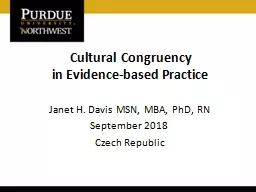

Janet H Davis MSN MBA PhD RN September 2018 Czech Republic Located on two campuses in Indiana USA Nursing Degree Programs Baccalaureate Degree Professional Option Baccalaureate Degree Second Degree Option ID: 790224
Download The PPT/PDF document "Cultural Congruency in Evidence-based P..." is the property of its rightful owner. Permission is granted to download and print the materials on this web site for personal, non-commercial use only, and to display it on your personal computer provided you do not modify the materials and that you retain all copyright notices contained in the materials. By downloading content from our website, you accept the terms of this agreement.
Slide1
Cultural Congruency in Evidence-based Practice
Janet H. Davis MSN, MBA, PhD, RN
September 2018
Czech Republic
Slide2Located on two campuses in Indiana USA
Slide3Nursing Degree ProgramsBaccalaureate Degree: Professional OptionBaccalaureate Degree: Second Degree Option
RN to BSN (online)
Clinical Nurse Specialist Master’s (Gerontology & Administration)
Family Nurse Practitioner (FNP)
Doctor of Nursing Practice (DNP)
Slide4Our Amazing Faculty
Slide5College of Nursing DistinctionsNLN Center of Excellence in Nursing Education
Indiana Center for Evidence Based Nursing Practice
Slide6PICO ModelThe PICO model is widely accepted for framing evidence-based practice questions.
Population
Intervention
Comparison
Outcome
Slide7Evidence-based PracticeEvidence based practice (EBP) is the integration of the best research with clinical expertise and patient values
Slide8Study Abroad
Slide9Study Abroad in NicaraguaIn June 2017 ,
14 undergraduate nursing students were placed at public clinics, homes and a children’s community center
Over the week long trip they
gained hands-on experience with health care
providers, patients,
and
community
members
Slide10Slide11Interventions based on EBP are not available in practice settings around the globe
Slide12Does it fit?EBP may not be the best fit culturally with the patient population
Slide13The GoalJust like evidence-based practice
Culturally
competent
care = Highest
quality
Slide14Values, beliefs, and behaviors about health and well-being are shaped by
Ethnicity
Gender
Language
Nationality
Occupation
Physical and mental ability
Race,
Sexual orientationSocioeconomic status
Slide15Cultural CompetenceDefined as the ability of healthcare providers to integrate an individual’s values, beliefs,
and behavioral factors into EBP interventions
Slide16The GapInclude culturally congruent practice standards reflecting Cultural background Language proficiency
Literacy
in the critical appraisal comparison and validation of interventions
Slide17StrategiesDevelop cultural competenceEngage stakeholders in systematic reviews
Slide18Cultural CompetenceA
set of academic and interpersonal skills that increase the understanding and appreciation of cultural differences and similarities within, among, and between groups
Slide19Requires a willingness and abilityTo draw on community-based values, traditions, and customs
To work with knowledgeable persons of and from the community in developing targeted interventions
Slide20Engaging Stakeholders For our review, what are important interventions ?Will the interventions make a difference ?Can you see a practical application of the review findings ?
Are these findings relevant to you ?
Based on your experience, are any interventions missing ?
Slide21ChallengesMeans and methodsGathering stakeholdersLanguageHuman subjects protection (IRB)
Slide22Public demand for nurses who are critical thinkers and good citizens of the world
Nurses know how to develop cultural competence
Nurses know how to engage stakeholders in systematic reviews
Slide23ReferencesGuise, J-M., O’Haire, C., McPheeters
, M., Most, C.,
Labrant
, L., Lee, K., Cottrell, E.K.B., & Graham, E. (2013). A practice-based tool for engaging stakeholders in future research: A synthesis of current practices.
Journal of Clinical Epidemiology
,
66
, 666-674.
Health Resources and Services Administration Bureau of Health Professions Division of Nursing (2004) Other definitions of cultural diversity. http://bhpr.hrsa.gov/diversity/cultcomp.htm , p.1Sackett, D.L.,
Straus,S
.,
Richardson,S
. Rosenberg, W., & Haynes, R.B. (2000). Evidence-based medicine: How to practice and teach EBM (2
nd
ed.). London: Churchill Livingston.
Wale, J. (n.d.)
An Introduction to Consumer Involvement in Systematic Reviews. Cochrane Consumer Network
. Retrieved from
https://training.cochrane.org/resource/introduction-
consumer-involvement-systematic-reviews.